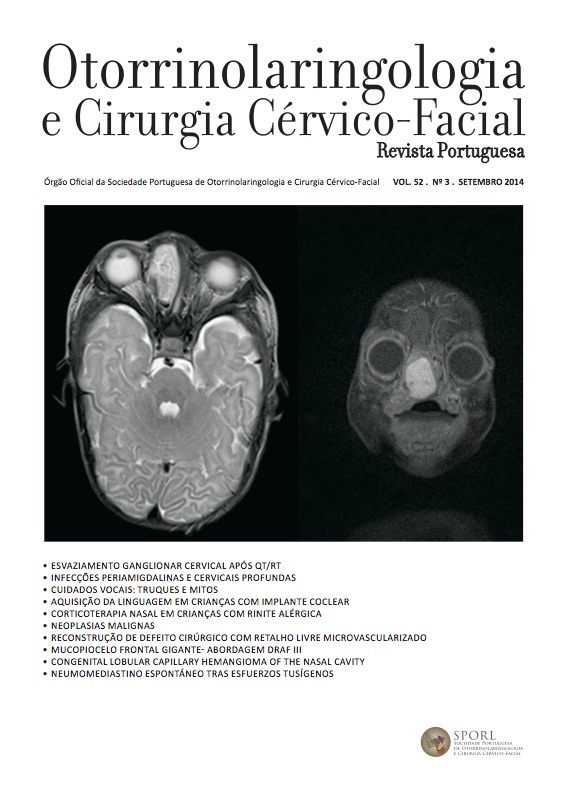Vocal care: Myths and tricks
DOI:
https://doi.org/10.34631/sporl.448Keywords:
Profissionais da voz, Mitos, TratamentoAbstract
Objective: This work aims to characterize non specialized behaviors related to voice, in order to study the habits, practices and alternative treatments, performed by professional voice users.
Study design: Cross sectional
Material and methods: It was created an anonymous survey that was distributed by different professional voice users groups. Various aspects related to training of these professionals, habits and voice care, complaints and alternative treatments were analyzed. Special attention was given for homemade recipes.
Results: A total of 134 surveys were analyzed. The majority of population was female (67.2%), with an average age of 43 years old. 73.8% used their voice professionally, and 38.8% had hobbies related to vocal use. 59.7% claimed to have knowledge of vocal hygiene, while 68.8% have no knowledge of vocal technique. Among the homemade remedies, honey alone (64.2%) or its association with lemon (56.7%) were the most often.
Conclusion: We need more training and information among voice professionals. Several habits and alternative therapies have been identified and need to be demystified.
Downloads
References
Aroson A E, Bless D M. Introduction to Clinical Voice Disorders. In: Clinical Voice Disorders. New York, Thieme; 2009:1-9.
Koufman JA, Isaacson G. Voice Disorders. Otolaryngology Clinics of North America. 1991, October, 24:965-1286.
Belau M, Feijó D, Madazio G, et al. Voz Profissional: Aspetos gerais e Atuação Fonoaudiológica. In: Belau M. Voz: O Livro do Especialista. Volume II. Rio de Janeiro, Reviter; 2001: 287-407.
Drumond LB, Vieira NB, Oliveira DSF. Speech-Language Pathology production regarding voice in popular singing. J Soc Bras Fonoaudiol. 2011;23(4):390-7.
Penteado RZ, Ribas TM. Educative processes in the vocal health of teachers: a literature review of Brazilian studies in Speech-Language Pathology and Audiology. Rev Soc Bras Fonoaudiol. 2011;16(2):233-9.
Ruben RJ. Morell Mackenzie’s The Hygiene of the Vocal Organs: a study in longevity or durability. Laryngoscope. 2014 Feb;124(2):522-30.
Timmermans B, Vanderwegen J, De Bodt MS. Outcome of vocal hygiene in singers. Curr Opin Otolaryngol Head Neck Surg. 2005 Jun;13(3):138-42.
Broaddus-Lawrence PL, Treole K, McCabe RB, Allen RL, Toppin L. The effects of preventive vocal hygiene education on the vocal hygiene habits and perceptual vocal characteristics of training singers. J Voice. 2000 Mar;14(1):58-71.
Babin E, Lemarchand V, Comoz F, et al. Laryngites chroniques de l’adulte. Encyclopédie Médico-Chirurgicale, Oto-rhino-laryngologie. 20-645-C-10, 2006: 1-10.
Belau M, Azevedo R, Pontes P. Conceito de Voz Normal e Classificação das Disfonias. In: Belau M. Voz: O Livro do Especialista.Volume I. Rio de Janeiro, Reviter; 2001: 53-84.
Aroson A E, Bless D M. Treatment of Voice Disorders. In: Clinical Voice Disorders. New York, Thieme; 2009: 231-70.
Behlau M, Oliveira G. Vocal hygiene for the voice professional. Curr Opin Otolaryngol Head Neck Surg. 2009; 17 (3):149-54.
Erickson-Levendoski E, Sivasankar M. Investigating the effects of caffeine on phonation. J Voice. 2011 Sep; 25(5):e215-9.
Sivasankar M, Leydon C. The role of hydration in vocal fold physiology. Curr Opin Otolaryngol Head Neck Surg. 2010 Jun;18(3):171-5.
Viola IC. Estudo descritivo das crenças populares no tratamento das alterações vocais em profissionais da voz. Tese de Mestrado – Pontíficia Universidade Católica de São Paulo. São Paulo,1997.






